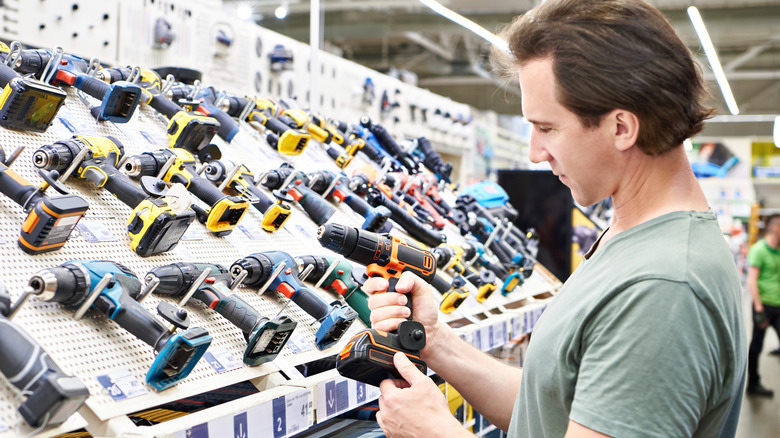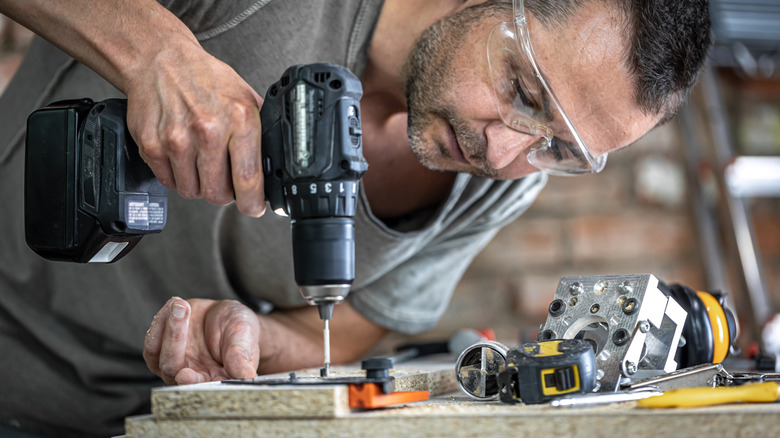Why It May Be Worth It To Splurge On A Quality Cordless Drill
It's easy to overlook a quality cordless drill when curating a home toolkit. After all, even budget versions can twist a screw or poke a hole in drywall without much fuss. But when your to-do list gets longer and more complicated, a cheap drill can start to feel a bit clunky and underwhelming. When assembling furniture or tackling larger DIY builds, a tool that's supposed to make things easier shouldn't also make you second-guess every squeeze of the trigger.
From a bird's-eye-view, we know that cordless drills sit at the intersection of convenience and capability, making it a must-buy power tool for first-time homeowners. Compared to their corded counterparts, they offer the kind of freedom that matters most when you're wedged behind a cabinet or up on a ladder. But within the cordless category itself, quality can vary widely. This is true of most battery-operated products, from electric vehicles to flatscreen televisions. That said, a good drill shouldn't just do the minimal required; rather, it ideally changes how you approach the job at hand, giving you more precision, more efficiency, and fewer stripped screws. And unlike flashier tools that mostly collect dust, a drill earns its keep with every picture hung or pilot hole bored.
So while it may seem like overkill to spend more on something that "just drills holes," the right tool can easily distinguish itself. It's not about brand loyalty or bells and whistles. It's about whether your gear can keep up when the work gets real.
The problem with budget drills
On paper, budget drills get a lot of things right (we tried the cheapest cordless power drill at Home Depot, so we know). They're typically lightweight, inexpensive, and perfectly adequate for low-stakes tasks like assembling a flat-pack desk or tightening cabinet hardware. But when you push beyond those limits, the shortcomings become quickly apparent. Limited torque settings and bare-bones motors mean less control and more wear on materials. Try adjusting a screw in particle board and you may find yourself stalling out. Or worse, spinning out the other end. We might describe this scenario as penny wise, torque-pound foolish.
Most entry-level drills lack key features like multiple speed settings, brushless motors, or hammer functions that allow you to drill into tougher surfaces like masonry. Instead, they tend to top out quickly in both power and precision. For anyone working on more than the occasional IKEA build, that can translate to stripped screws and the slow realization that your tool just isn't up for the job.
Ergonomics also suffer. Budget drills tend to prioritize low cost over comfort, resulting in designs that feel awkward in hand after just a few minutes of use. The difference is subtle at first, but over time, even small inefficiencies can lead to fatigue and mistakes. In short, saving a few bucks upfront often leads to spending more time (and effort) compensating for your drill's limitations.
Why a quality cordless drill really ups your game
A high-quality cordless drill isn't just a nicer, luxe version of a cheaper, bare-bones tool. Rather, it's a fundamentally better experience. Modern premium drills often include brushless motors, which last longer, run cooler, and deliver more torque without burning through battery life. Instead of fighting with your drill, you can trust it to handle tasks that range from delicate jobs like installing cabinet hinges to heavy-duty work like boring into concrete with a hammer function.
While it won't magically fly to you on command like Thor's Mjolnir, a high-quality, top-rated cordless drill does bestow a good balance of power and control. Adjustable clutch settings, variable-speed triggers, and multiple gear ratios allow for precision that budget tools just can't replicate. This means fewer stripped screws, cleaner holes, and less damage to materials. This is especially so in sensitive builds like chipboard furniture. Features like anti-rotation technology and LED lights can help protect your wrists in case of sudden jams and improve accuracy in low-light corners or tight workspaces.
Long-term, the value adds up. Better battery systems mean fewer interruptions and faster charging. Solid build quality translates to fewer replacements. And if you're reaching for your drill often, as many homeowners, hobbyists, and professionals do, it becomes less of a "splurge" and more of a strategic investment. The drill doesn't just do more. It makes you feel more capable every time you pick it up.


